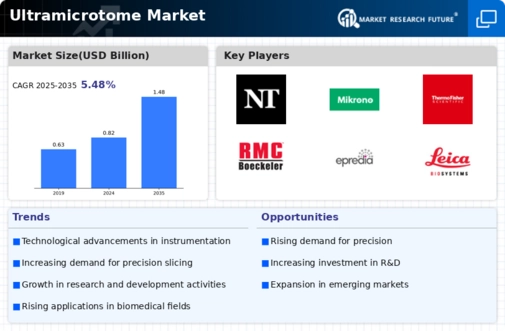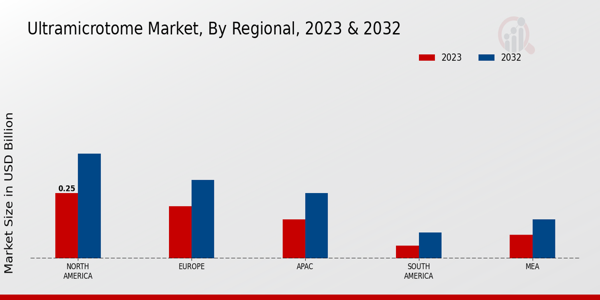Market Growth Projections
The Global Ultramicrotome Market Industry is poised for substantial growth, with projections indicating a market value of 0.82 USD Billion in 2024 and an anticipated increase to 1.48 USD Billion by 2035. This growth trajectory reflects a compound annual growth rate of 5.49% from 2025 to 2035. Factors contributing to this expansion include technological advancements, rising research activities, and increasing demand in healthcare. As the market evolves, it is essential for stakeholders to monitor trends and adapt to the changing landscape, ensuring they remain competitive in a dynamic environment.
Rising Research Activities
An increase in global research activities across various fields, including biology, materials science, and nanotechnology, is propelling the Global Ultramicrotome Market Industry. Institutions and laboratories are investing heavily in advanced microscopy techniques, which require high-quality ultramicrotomes for sample preparation. This trend is particularly evident in academic and industrial research settings, where the demand for precise and reproducible results is paramount. The anticipated growth in research funding and collaboration initiatives suggests a favorable environment for ultramicrotome adoption. Consequently, the market is expected to expand significantly, with projections indicating a value of 1.48 USD Billion by 2035.
Technological Advancements
The Global Ultramicrotome Market Industry is experiencing a surge in demand due to rapid technological advancements. Innovations in ultramicrotome design and functionality, such as improved blade materials and automated systems, enhance precision and efficiency. For instance, the introduction of diamond knives has significantly improved sectioning quality, allowing for thinner slices and better sample integrity. This trend is likely to drive market growth, as researchers and laboratories increasingly seek high-performance equipment to meet their analytical needs. As a result, the market is projected to reach 0.82 USD Billion in 2024, indicating a robust growth trajectory.
Growing Focus on Nanotechnology
The Global Ultramicrotome Market Industry is significantly influenced by the growing focus on nanotechnology research. As industries explore the potential of nanomaterials and their applications, the need for precise sample preparation becomes increasingly critical. Ultramicrotomes are essential for obtaining ultra-thin sections of nanostructured materials, enabling detailed analysis and characterization. This trend is evident in sectors such as electronics, pharmaceuticals, and materials science, where the demand for high-quality samples is paramount. The increasing investment in nanotechnology research and development is likely to bolster the ultramicrotome market, creating opportunities for innovation and growth.
Increasing Demand in Healthcare
The Global Ultramicrotome Market Industry is witnessing heightened demand in the healthcare sector, particularly in pathology and diagnostics. As the need for accurate tissue analysis and histopathological examinations grows, ultramicrotomes play a critical role in preparing samples for microscopic evaluation. The rise in chronic diseases and the aging population further amplify this demand, as healthcare providers seek to enhance diagnostic capabilities. Moreover, advancements in medical imaging technologies necessitate the use of high-quality ultramicrotomes to ensure optimal sample preparation. This trend is likely to contribute to a compound annual growth rate of 5.49% from 2025 to 2035.
Expansion of Educational Institutions
The expansion of educational institutions and research facilities globally is positively influencing the Global Ultramicrotome Market Industry. As universities and research centers enhance their capabilities, the demand for ultramicrotomes increases to support advanced research and training programs. This trend is particularly pronounced in emerging economies, where investments in higher education and research infrastructure are on the rise. The establishment of specialized laboratories equipped with state-of-the-art ultramicrotomes facilitates hands-on learning and innovation. Consequently, this growth in educational institutions is expected to drive market expansion, fostering a new generation of researchers equipped with advanced tools.

















